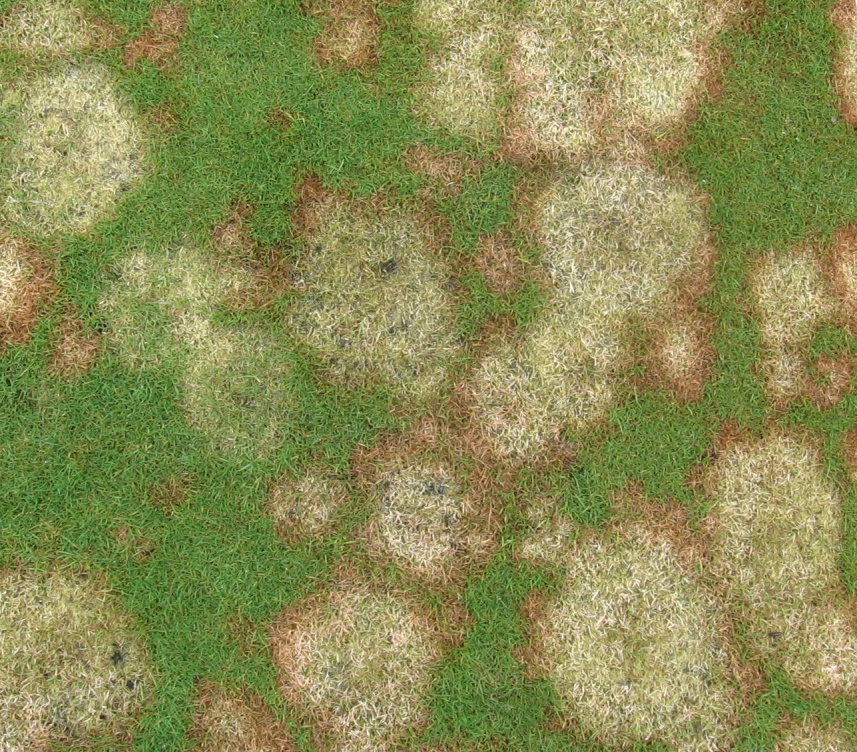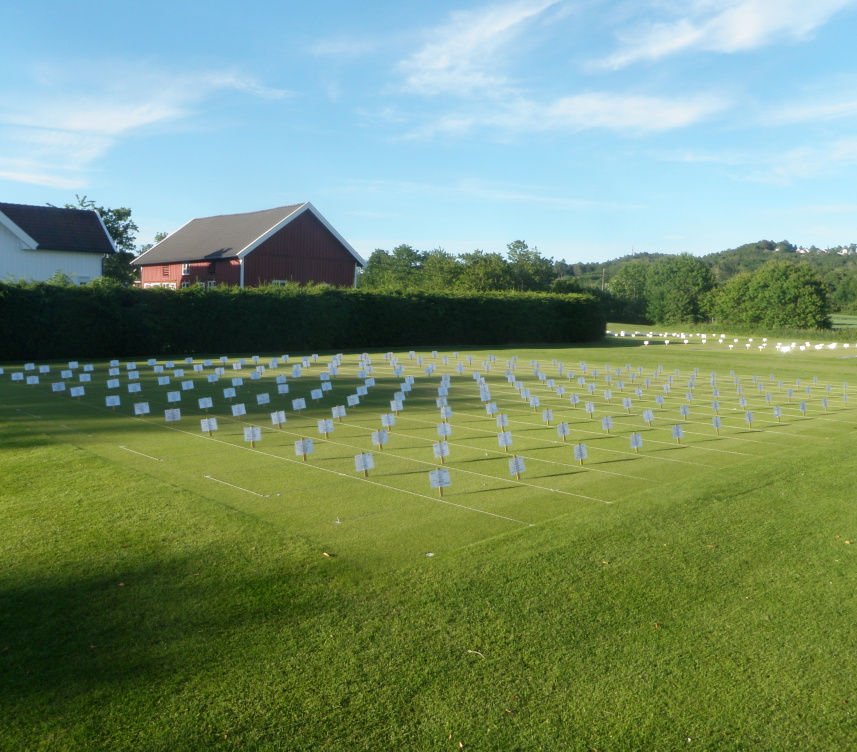

The Implications of Integrated Pest Management on Golf Courses
Trygve S. Aamlid, coordinator for STERF’s IPM program Trygve.Aamlid@nibio.no
The official definition of IPM is ‘Integrated Pest Management’. This implies a focus on weeds, insects and diseases, but IPM on golf courses goes well beyond that: It is all about growing healthy, disease-resistant and stress-tolerant grass plants that together form high-performance playing surfaces. In this regard, I tend to agree with the alternative, unofficial definition of IPM as ‘Intelligent Plant Management’. The broadness of IPM on golf courses is reflected in the Scandinavian Turfgrass and Environment Research Foundation's (STERF) digital IPM library (http://www.sterf.org/sv/library/fact-sheets-ipm) where you will find fact sheets not only about weeds, insects and diseases, but also on agronomic practices such as irrigation, fertilization, topdressing and thatch control, and on optimal choice of grass species and varieties for golf courses in various parts of Scandinavia.
Many greenkeepers associate IPM with a decreased use of pesticides. This is not surprising as STERF’s first IPM program was developed in 2010-11 in direct response to the EU’s directive 128/2009 on ‘Sustainable Pesticides Use’. It is also in agreement with the major IPM principle that pesticides shall not be used prophylactically (programmed) but only as a last solution when other measures are not sufficient. However, a reduction in total pesticide use does not necessarily imply a reduction in the number of active substances on the market. On the contrary, access to a wide range of effective substances with various modes of action will most likely reduce the risk that weeds, insects or pathogens develop pesticide resistance, and it will also increase chances that at least one substance on the market has acceptable effect on the target organism.
STERF has, in its revised IPM program for 2016-2021, identified three categories of IPM projects:
- Breeding, evaluation and management of turfgrass species and varieties that are (i) competitive against weeds, (ii) have a minimum level of resistance to the most common and harmful insects and pathogens on Nordic golf courses, and (iii) tolerate stresses such as shade, drought, heat and ice encasement etc.
- Identification, biology and proliferation of harmful organisms
- Safe and more efficient use of chemical and alternative pesticides
The purpose of this article is to show some examples of ongoing and possible new STERF projects within each of the three categories. Knowledge gaps identified in the IPM program are important for turfgrass scientists, advisors and practitioners who are considering submitting an application at STERF’s next call for proposals in 2019.
Category 1: Breeding, evaluation and management of weed-competitive, disease-resistant and stress-tolerant turfgrass species and varieties
STERF’s most important project for evaluation of turfgrass germplasm is SCANGREEN which started in 2003 and is now in its fourth test round. This project is the basis for the recommended variety lists at www.scanturf.org and www.sterf.org showing characters such as overall impression (turf quality), tiller density, color, winter resistance and turfgrass growth rate. From these lists you will also, depending on species, be able to rank varieties for susceptibility to microdochium patch (Microdochium nivale), red thread (Laetisariafuciformis), take-all patch (Gaeumannuomyces graminis) and rust (Pucciniasp.) during the growing season, and to pink snow mold (Microdochium nivale), and gray snow mold (Typhula incarnata) during the winter.
(Microdichium Nivale/ A. Kvalbein)
Unlike most other variety testing programs, SCANGREEN is also open for testing of turfgrass mixtures and blends. In the ongoing round, we have, for example, included the mixtures of red fescue (Festuca rubra) & creeping bentgrass (Agrostis stolonifera), and red fescue & velvet bentgrass (Agrostis canina) in comparison with the more commonly used red fescue & colonial bentgrass (Agrostis capillaris). We also compare rough bluegrass (Poa trivialis) or perennial ryegrass (Lolium perenne) as possible nurse grasses when establishing new creeping bentgrass greens or reseeding creeping bentgrass greens after winter damage. Since it started in 2003, preliminary results from SCANGREEN have sometimes triggered more in-depth research into species that might have an unexploited potential on Nordic golf courses, such as red fescue (project ‘Fescue Green’) and velvet bentgrass (project ‘Velvet Green’).
(SCANGREEN Project - Testing of turfgrass species and varieties/ T. Aamlid)
Since its first project on demand-driven fertilization around 2005, many STERF projects have looked into optimal nitrogen (N) rates and distributions during the growing season to various grass species. Here there is often a conflict between IPM interests, as grass competition against dandelions (Taraxacum officinale), plantains (Plantagosp.) and white clover (Trifolium repens) require higher N rates than what is optimal to avoid microdochium patch or thatch accumulation. On the other hand, low-N-diseases such as anthracnose (Colletotrichum graminicola), red thread, dollar spot (Clarireedia sp.) and take-all patch are usually easier to control with enhanced N inputs. In the ongoing Sustainable Phosphorus Nutrition (SUSPHOS) project, the focus has been shifted from nitrogen to phosphorus (P), which is a key element when it comes to leakage and surface runoff from golf courses to surface water and ground water. P is the element of which the world’s mineral resources are most limited, and eutrophication, i.e. the growth of algae in dams and lakes, is often an indication of excessive fertilization with this element.
Another area also included in this category is the search for stronger and healthier plants using biostimulants. Many of STERFs industrial partners have interesting products that contain micronutrients, humic acids or sea weed extracts. STERF has already started testing the effect of some of these products on microdochium patch, and more projects are likely to follow during the program period. Sillicon (Si) is another element that may deserve some more attention when it comes to disease resistance.
Most STERF projects so far have considered annual bluegrass (Poa annua) as a foe and focused on how to get rid of this species on greens, tees and fairways. It is, however, a fact that almost half of the roughly one thousand golf courses in the Nordic countries have greenkeepers who have decided to consider annual bluegrass as a friend and make the best out of this highly adaptive grass species on their playing surfaces. For this reason, STERF’s IPM-program for 2016-2021 specifically mentions the need for more research into optimal management of Poagreens with less use of pesticides.
Category 2: Identification, biology and proliferation of weeds, insect pests and diseases
Early and accurate identification is always a prerequisite for successful control of harmful organisms. Several laboratories, including Botaniska Analysgruppen (Marina Usoltseva) in Sweden, Asbjørn Nyholt ApS (Karin Normann) in Denmark, and NIBIO Turfgrass Diagnostic (Tatsiana Espevig) in Norway offer diagnostic services and recommendations for insect and disease control. These laboratories also collaborate on identification and control of dollar spot, which is currently the largest STERF project in this category. Important topics here are susceptibility of different grass species and varieties to contrasting isolates of dollar spot from the Nordic countries, UK and USA, and the effect on dollar spot of maintenance practices such as N fertilization and regular rolling of the putting greens. Although not a STERF project, the Danish Golf Union has also initiated trials investigating the efficacy of fungicides that are already on the Danish market against the type of dollar spot occurring on Nordic golf courses.
Golf is a sport for which not only top athletes, but also average players, often travel to countries further south to play the game. An important question is to what extent this golf tourism poses a risk for spreading harmful organisms on golf shoes, golf clubs etc. The question has relevance for insect pests and pathogens, but also for invasive weeds which are likely to take foothold in countries further north due to climate change. This is an area that national authorities should keep a close eye on, and joint proposals dealing with phytosanitary requirements and measures to prevent negative side-effects of golf tourism are therefore likely to have a high priority at STERF’s next allocation of research grants.
By far, the biggest consumption of pesticides on golf courses is herbicides. In order to control dandelions, plantains, daisies (Bellis perennis) and other broadleaved weeds using mechanical or thermal means, sometimes combined with a minimum of targeted herbicide applications, more knowledge is needed about the biology of these species when exposed to a frequent cutting regime. Most of the typical lawn weeds show both plasticity and genetic adaptation, and their biology and weak points may well be different from those earlier documented in grasslands with only two or three cuts per year.
Category 3: Safe and more efficient use of pesticides
The third category is included in STERF’s IPM program in recognition that golf course management entirely without pesticides is extremely difficult and perhaps unrealistic, at least in the short-term. Together with the pesticide industry it is therefore important to evaluate the efficacy and selectivity of new products coming to the market. The turfgrass, let alone golf, market in the Nordic countries is too small to make it cost-effective for the pesticide industry to develop new active substances only for turf, and the closest we get to ‘special turfgrass products’ are therefore new formulations of active substances that have developed for agriculture already. Medallion, which is currently one of the most commonly used fungicides against microdochium patch on Swedish, Norwegian and Finnish golf courses, is an example of such a special turfgrass formulation of the active substance fludioxonil.
The pesticide industry can, however, also decide to provide the necessary documentation to have golf courses and other turfgrass areas included on the ordinary label for agricultural products, and there is also a possibility that the national golf federations and greenkeeper associations can apply for minor use registration, at their own risk, of products that do not have turfgrass on the ordinary label. In the Nordic countries, the latter possibility has been most actively exploited by the Danish Golf Union, but there are also examples from the other countries, e.g. a recent minor use registration of the agricultural product Amistar (azoxystrobin) for control of take-all patch on Norwegian golf courses. To what extent this possibility will be exploited in the future will partly depend on how active Syngenta, Dow, Bayer and other pesticide companies are in including turfgrass on their ordinary labels. For the golf industry it is also a question to what extent it can be proved if turfgrass formulation offers enough benefits vs. agricultural formulation to justify a higher price. This is a very applied research area that STERF, together with the pesticide industry, should like to look more into in the future.
About Sterf
STERF (Scandinavian Turfgrass and Environment Research Foundation) is the Nordic golf federations’ joint research body. STERF supplies new knowledge that is essential for modern golf course management, knowledge that is of practical benefit and ready for use, for example directly on golf courses or in dialogue with the authorities and the public and in a credible environmental protection work. STERF is currently regarded as one of Europe’s most important centres for research on the construction and upkeep of golf courses. STERF has decided to prioritise R&D within the following thematic platforms: integrated pest management, multifunctional golf facilities, sustainable water management and winter stress management. More information about STERF can be found at www.sterf.org

